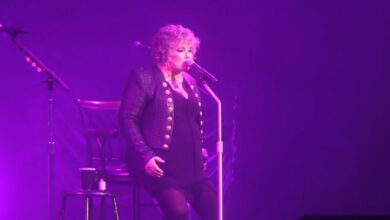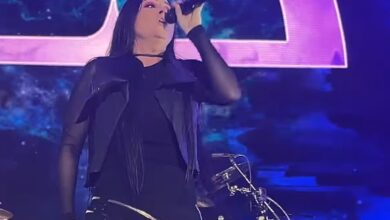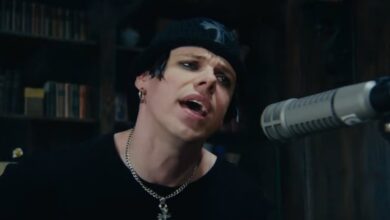Metallica Unleashed a Historic Night of Fire, Power, and Pure Stadium Chaos at Sydney’s Accor Stadium 2025
From the moment the sun rose over Sydney on 15 November 2025, the city felt less like a harbour town and more like a staging ground for a metal pilgrimage. Trains heading toward Olympic Park were packed with black shirts, worn denim and fresh M72 tour merch. Fans compared stories from Perth, Adelaide, Melbourne and Brisbane, ticking off which deep cuts they had heard so far and speculating about what surprises might be saved for the final Australian show at Accor Stadium.
The build-up had already begun days earlier on Oxford Street, where Metallica opened a pop-up store that turned Paddington into a temporary fan village. People camped on the footpath for up to thirteen hours just to be first in line for limited posters, skateboards and city-specific shirts. Some fans had followed the band across multiple states; others were seeing them for the first time. All of them spoke about Sydney as if it were a last chapter, something too important to miss.
By late afternoon the concourses around Accor Stadium were a blur of movement. Security staff tried to keep the streams of people moving while friends posed for photos under the M72 banners. You could hear accents from all over Australia, sprinkled with visitors from New Zealand, Asia and Europe who had timed holidays around this date. The knowledge that this was Metallica’s first Sydney concert in more than a decade added a tight, electric edge to the excited chatter drifting through the concrete walkways.
Once the gates opened fully, fans poured into the bowl and finally saw the full M72 set-up with their own eyes. Instead of a traditional stage at one end, a circular platform sat in the middle like a steel island, ringed by towering speaker columns and LED screens. The floor wrapped around it, divided by the Snake Pit in the centre, so that no matter where you stood, one of the four band members would eventually be right in front of you. Even before the music started, people were pointing at the towers and speculating how big the pyro would be.
Suicidal Tendencies were first to attack the in-the-round stage, blasting through their set with skate-punk ferocity that had the early floor moving in chaotic circles. Mike Muir sprinted from one side of the ring to the other, hurling lyrics and grins in equal measure. It felt like the loosest, wildest house party imaginable, scaled up to stadium size. By the time they were done, sweat was already dripping from denim vests and many fans were on their second or third bottle of water.
The mood shifted sharply when Evanescence stepped out at 7 pm. Where Suicidal brought frantic energy, Amy Lee and her band brought drama. Huge screens filled with stormy imagery as her voice climbed over the stadium, soaring on songs like Going Under and My Immortal. At moments the crowd fell almost silent, thousands of people just watching and listening, phone lights flickering like candles. When they closed with Bring Me To Life, the whole venue sang the verses that once belonged to a guest rapper, turning it into a communal anthem.
@accorstadium Our house full of #Metallica fans 🤯 #sydney #accor #fan #concert ♬ original sound – Accor Stadium
As the sky darkened properly, familiar bagpipes blasted from the PA: AC/DC’s It’s a Long Way to the Top rolled across the stadium as a pointed salute to Australian rock history. Fans roared along, using the song as a final warm-up. Then the lights dropped again and Ennio Morricone’s The Ecstasy of Gold swept in, sending a wave of goosebumps up arms and necks. Conversations stopped mid-sentence. For many people in that bowl, it had been twelve long years since they last heard that intro in their own country.
When Metallica finally strode onto the circular stage and slammed into Creeping Death, the release was total. The sound jumped from the central platform to the upper levels with shocking clarity, supported by the 360-degree speaker towers. On the floor, bodies surged forward as James Hetfield yelled the opening lines, while up in the stands people grabbed the railings and shouted along, turning the first chorus into a declaration that the band was truly back on Australian soil.
Without much pause the band locked into For Whom the Bell Tolls, Robert Trujillo’s bass echoing around the stadium like a distant artillery blast. The pace slowed, but the weight doubled. Heads rolled in slow unison, arms punching the air on each snare hit. Blue and grey lights washed over the stage, making the four musicians look like silhouettes cut from steel. You could feel the song’s history in every movement, as if decades of gigs in clubs and arenas were echoing through this single performance.
Fuel then ripped the throttle wide open. Columns of flame erupted around the circular stage, heat slapping faces on the floor and even reaching up into the lower bowl. The familiar intro line detonated a roar that almost drowned out the band’s monitors. People jumped in loose circles, beer flew into the air, and for a few minutes the entire stadium felt like the inside of a roaring engine. Fans who had seen earlier shows on this leg insisted afterward that Sydney got the most savage version of the song yet.
The middle of the set brought a darker, more dynamic stretch. Cyanide and The Day That Never Comes showed the band’s later catalogue still had sharp teeth, while The Unforgiven turned the bowl into a huge choir. Wherever I May Roam swaggered across the stage with its nomadic riff, the lights painting shifting patterns that made the floor look like a moving desert. Every few songs, the band rotated positions, making sure each quadrant of the stadium got its own up-close moment with different members.
One of the most uniquely Australian pieces of the night came when the show paused for the Kirk and Rob doodle. The guitarist and bassist claimed the stage for themselves and launched into a medley built around For Those About To Rock and Nice Boys Don’t Play Rock ’n’ Roll, paying tribute to AC/DC and Rose Tattoo. Hearing those homegrown riffs blasted back at a packed Accor Stadium by a visiting band gave the night an extra layer of connection, and the response from the crowd was deafening.
Midway through the performance, the volume dropped not for a ballad, but for a moment of human focus. James took the microphone and introduced Hugo, a young fan whose dream of seeing Metallica live had been realised that evening through the Make-A-Wish Foundation. Cameras zoomed in on the boy as tens of thousands of strangers applauded him. James spoke about struggle, resilience and the strange family that has grown around this music over four decades. For a few minutes the stadium felt smaller, like a single shared room.
The emotional thread carried perfectly into Nothing Else Matters. Phone lights rose like a galaxy, swaying slowly as the familiar arpeggios rolled out. Couples held each other; old friends leaned together, eyes closed; some people simply stared in silence. The song might be over-played in streaming statistics, but in that moment it felt newly fragile and sincere. When the last note rang, the cheer that followed sounded less like noise and more like gratitude.
Of course, gratitude soon turned back into chaos. Seek and Destroy brought out the giant black beach balls that bounced across the floor and stands, sometimes vanishing into pits of bodies before popping back up several rows away. Lux Æterna flashed by in a blaze of speed, reminding everyone that the band’s newest material could stand toe to toe with the classics. Sad but True, meanwhile, dropped like a concrete slab, its grinding groove making even the most exhausted necks start moving again.
As the night leaned into its closing stretch, the show took on a more cinematic feel. One arrived with stuttering lights and distant-sounding explosions, mimicking battlefield chaos as the song shifted from mournful intro to frantic climax. Master of Puppets, by now a global hymn for metal fans of every age, turned the stadium into one huge gang chorus, hands chopping in the air on the title line. Even fans who had discovered the band through television shows and memes seemed to know every twist of the song.
Enter Sandman finally roared out as the last statement of the night, not just a crowd-pleaser but a victory lap. The stadium, already hoarse, found one more surge of energy as tens of thousands of voices shouted the lullaby lyrics together. Fireworks cracked overhead, smoke drifted across the upper tiers, and the band moved around the circle one more time, tossing picks, drumsticks and thank-yous in every direction. It felt less like a goodbye and more like a promise to return sooner than twelve years this time.
When the house lights came up and people began streaming out through the tunnels, there was a buzzing, exhausted happiness in the air. Some fans compared this show with earlier Australian tours, arguing over whether 2025 had somehow topped the legendary visits of the nineties. Others were simply stunned that a band with members in their late fifties and early sixties could still summon this amount of physical and emotional force. Outside the stadium, ride-share queues stretched long into the night as people replayed favourite moments into their phones.
In the days that followed, social media timelines filled with clips labelled Sydney 2025, shaky 4K footage capturing everything from the first blast of Creeping Death to the last firework over Enter Sandman. Fans swapped stories in comment threads, sharing photos of merch hauls from the pop-up shop and grainy zoom-ins of Kirk and Rob’s Aussie rock medley. Again and again one theme kept coming up: after twelve years away, Metallica had not just returned to Sydney; they had reclaimed it, turning one Saturday night at Accor Stadium into a memory that would echo for years.





